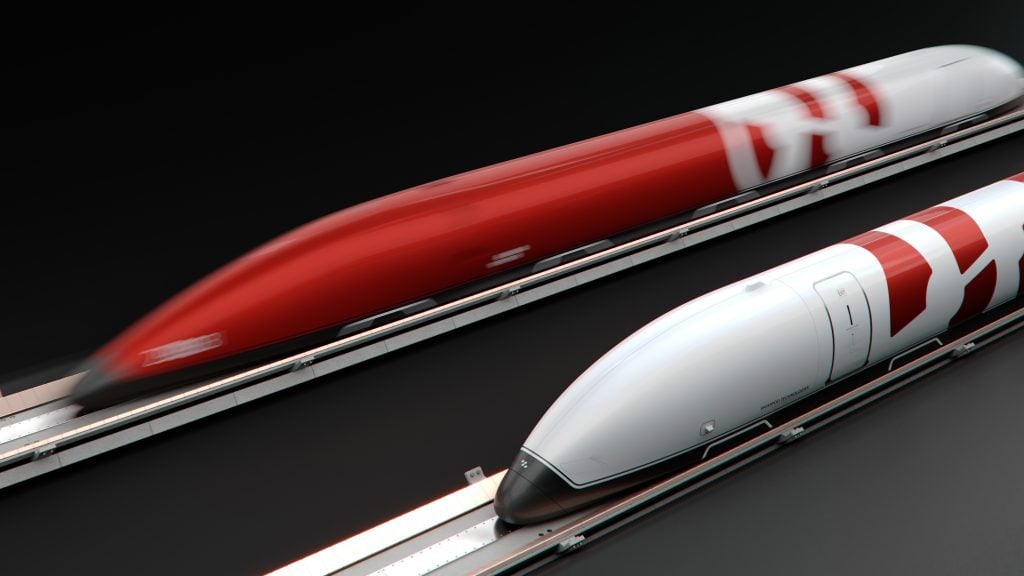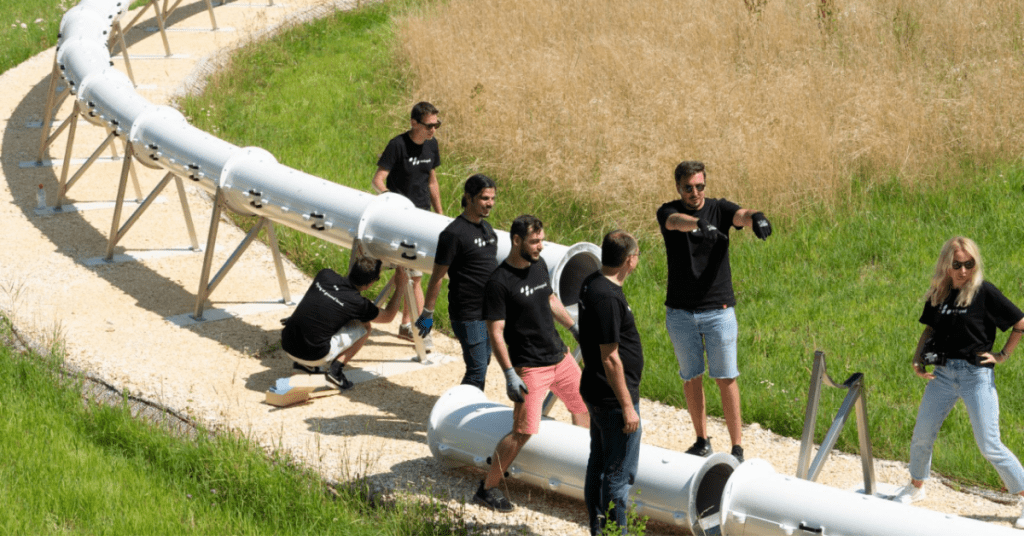It’s a torrid summer day and you would prefer to spend it on the beach. But you only have half a day off and the beach is a three hour distance by car. Out of my apartment in Bucharest, I’ve lived this scenario countless times. So when I heard about a near future when I could hop on a tube and get to the seaside in less than 20 minutes, I jiggled with anticipation.
Denis Tudor depicted this scenario for me when I asked about the potential of the hyperloop, a new mode of transportation that will be much easier to implement than it sounds. That is because the team at the Swisspod hyperloop startup, co-founded by Denis (CEO) and Cyril Dénéréaz (CTO), already worked out the technological innovations necessary to build a mobility solution competitive to high-speed railway and even airplanes.
From their facilities in Switzerland and the US, Swisspod is building the most affordable and energy-efficient pods that will enable the future of high-speed travel. They are an EPFL (École polytechnique fédérale de Lausanne) spinoff founded in 2019 by industry veterans and winners of the SpaceX Hyperloop Competition.
Denis Tudor, who we interviewed today, has recently concluded the first PhD on hyperloop worldwide. What follows is a conversation about what makes hyperloop a mobility solution of the future and we’ll learn just how distant that future is. He also reminisces about his experience collaborating with Elon Musk on the first hyperloop system tests and shares what comes next for Swisspod after announcing a new funding round on European investment platform SeedBlink.
The Recursive: In a nutshell, what is hyperloop transportation?
Denis Tudor, co-founder Swisspod: A new mode of transportation similar to a train. You have a tube and get rid of the air inside it. And this low-pressure environment or vacuum tube allows a network of capsules or trains to travel at really high speeds.
Its main advantages are speed – it can go up to 1200 kilometers an hour, energy efficiency and sustainability. It’s all-electric. It can be on-demand, autonomous, and transport passengers and freight.
What are the transit or logistics situations where it’s more advantageous to hyperloop over other transportation forms?
We are in close discussions with local players here in Switzerland, and the main application consists of quickly connecting airports to distribution hubs or warehouses. In this way, we obtain a mutual gain. For example, we have a distribution hub here in Switzerland, which is not very well connected to the Geneva airport. So if Swisspod makes a connection between the airport and this distribution hub, the packages will be transported energy efficient and with a lower carbon footprint.
Transportation is also conducted faster and in a predictable manner because we have a constrained environment, thus with no external perturbations in the system that affect the timing. It would also be autonomous, so independent of driver shortages.
And we’re looking at the possibility of powering it up with solar panels on top of the tube to make it energy self-sufficient. Some of the systems can be above the ground, others underground. It depends on the geography. We want to use the existing medians of the highways so that we don’t need new infrastructure for this system. For instance, we can place one or two tubes in the middle of the highways like you have monorail systems currently in Miami or Chicago.
At the end of the day, the passenger will take advantage of not having trucks on the highway.

What are the technical elements and innovations that make it possible?
At Swisspod, we built an innovative propulsion system which can accelerate vehicles up to 200 kilometers an hour. And that’s our unique selling point. The induction motor is a contactless-based propulsion system that functions based on electromagnetic fields. You generate the magnetic field that propels you inside this vacuum tube. And this is powered up by a battery pack that is four or five times bigger than a Tesla cybertruck. So it’s a different type of battery system which can offer a high discharge, high power, and not a lot of energy requirements. So just those stay simple. It’s a contactless propulsion system. On top of that, we have a pressure vessel, like a pressurized room, where passengers or freight can sit.
Do you have any constraints on the resource procurement part?
For our special battery pack, we work with a South Korean company. We are currently in the prototype phase, still testing our technology, and we don’t need vast amounts of cells. We haven’t experienced issues with batteries; we ordered them some time ago, and they can sit without losing their properties. However, we had this problem with the rail production of the testing facility in Switzerland because the rails are made of steel. Since the steel in Switzerland and probably from Europe is coming from Russia, there was a shortage of material in the country. However, we managed to overpass this situation.
Where are we today in terms of the development of hyperloop technology at a global level?
We have several competitors in the world nowadays coming from different countries. Our main competitor was called Virgin Hyperloop One and had Richard Branson as a Chairman. However, I think they had some issues – they laid off some people in the last couple of months, and they also lost the Virgin branding and Richard Branson.
On the other hand, our oldest competitor, HyperloopTT, announced they plan to go public on NASDAQ. So, there’s both good news and bad news in the industry.
At Swisspod, I think we’ve made most of the advancements in technology. We have a close partnership with one of the local universities here in Switzerland. They allocated a lot of funds to develop these technologies, which are built based on a philosophy I developed during my PhD.
What motivated you to work on this technology and, taking a step back, enable super-fast travel?
When I started, it was just pure curiosity. It was an excellent opportunity for me to work on a very cool type of project. Regarding the other question, I think the world needs a new transportation system. In the last 100 years, we haven’t had any advancements in transportation systems. We need to come up with an alternative for the aviation sector. The way we travel nowadays at high speeds is not the most sustainable. We need something competitive in terms of the carbon footprint. So I think there is a clear need for the hyperloop on the market, which motivates me to keep going.
Between 2016-2018, you won different awards in the SpaceX Hyperloop Competition. How was that experience for you?
Graduating from the SpaceX school was great. It was a great engineering exercise and an opportunity to work with the most brilliant engineers in the world. For four years, we worked on various systems of the capsule. However, the facilities were quite limited due to the short trajectory length- around a couple of hundred meters. So we needed to address the problem differently by building an infinite, circular facility to challenge our technology for high speed and long distances.
But what SpaceX and Elon Musk did, investing 200 million dollars in a facility and allowing people to test their solutions, was unique. They should be congratulated for their contribution to this market.
In 2021, you launched the first hyperloop testing site in Europe. What critical engineering, business, and other hurdles have you had to overcome to this point?
Production is much different than prototyping. So we observed that there are other challenges when it comes to producing 500 pieces or 1000 pieces of rails or tube designs, with various elements coming from China and India. Building the infrastructure is not the easiest part.
But just to get on the funnier side of it, we had a funny story with one of the vacuum pumps that was not running, and we didn’t know what was happening. So, when we unscrewed the pump to find the issue, we found an unexpected one – a nest of mice. So the lesson for us was that the theoretical model is one thing, but when you face the real world, you need to add all these new dimensions.

What time frame are you targeting for commercializing hyperloop solutions?
We are now testing the technology, but from technology to the product, there is one more step. For that, we built a facility in Colorado, US. I think we can develop a freight solution for freight transportation in the next couple of years. Four years would be a reasonable estimate. Of course, we will test this at lower speeds, but I think it will be an excellent initial step for the market.
The vision of Swisspod is always going to be about transporting passengers. That’s the most exciting. But I think we need to be more pragmatic regarding the market opportunity. I think freight is the way to benchmark safety and create standards and regulations for commercial routes. I think that’s the logical approach.
For passengers, the speed but also the safety element should be higher, and we probably need another ten years to reach that point. Yet, when we talk about freight transportation, we can also transport five or six passengers in one shot, which is also a great opportunity. We can have fewer performant capsules and fewer passenger seats inside the capsule to start with.
You recently announced targeting a new funding round on Seedblink. What are the goals with the new capital?
So, the development in Switzerland has been financed with a grant by the Swiss government until 2025. Using the grant has been a very smooth process. In four years of operations, we had only one checkpoint.
However, we need to invest more private capital at this stage for the US development. With the money we are raising in this round, we will invest in the testing facility in Colorado and develop the product itself – the full-scale capsule. What Swisspod is doing in Switzerland is a reduced-scale model.
With Swisspod, you have built partnerships across both Europe and the US. What interest do you see on both sides of the Atlantic?
The environment in Switzerland is relatively stable, and it’s a great place to innovate. We would be honored to offer this technology to Switzerland, even for free. The railway transportation system in Switzerland is almost perfect, so there is no need for an alternative in the next couple of years. However, the biggest markets for them nowadays are the US, India, and China, so we have to have a presence in these countries as well.
You have Romanian investors onboard. What potential do you see for hyperloop technology in Romania and the region?
There are two sides. Romania hasn’t shown so far that it’s the most innovative country. They never adopted something risky in the past. However, look at the story of the internet infrastructure development in Romania. It can give you a great image of the country’s potential, which doesn’t have an excellent public transportation system, to make the jump to the hyperloop directly because it’s an affordable and competitive solution to a high-speed rail system. And it’s not tricky nor risky to implement a hyperloop system.
Why not look at the countries where there is a real need and thus market opportunity? Romania is one of those countries, especially for connecting big cities like Bucharest, Cluj and Constanta. Think about the chance to get from the capital to the beach in only 15 minutes during the summer.








